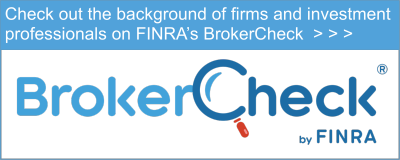October 2016 News
Market Volatility and Nervousness Are Back
After a summer of eerie calm and irrational record highs, volatility has returned to the financial markets just in time for fall – but for how long, and how bad could it get? No one knows, of course, but with the global economy still in shambles and the Federal Reserve still caught in the same interest rate conundrum I’ve been talking about for nearly two years, there’s a chance this roller-coaster ride could last awhile – with the dips and drops getting steeper the whole time.
So, what got Wall Street nervous again? On September 8th, European Central Bank President Mario Draghi gave a speech that some took as a sign that our own Fed might raise short-term interest rates again at its September meeting. As a result, the stock market experienced its most dramatic one-day plunge since late June, with the Dow dropping nearly 400 points and all 10 sectors in the S&P 500 ending up in the red.* It was the biggest intraday drop since June 24th, when the market tumbled in reaction to the Brexit vote.
Volatility Spike
Although the Fed didn’t end up raising rates, the nervousness sparked by the possibility has continued with a dramatic increase in daily and weekly market volatility. This comes after an almost bizarrely calm summer, in which the markets spiked to record highs in mid-July and hovered at those levels for almost exactly two months. This happened despite no noteworthy improvement in our economy or in the turbulent global economic picture. In fact, the second quarter saw GDP growth actually shrink compared to last year,** and it also marked the first time since The Great Recession of 2008 that the S&P 500 posted five consecutive quarters of year-over-year declines in earnings.***
But with the arrival of fall (typically a time of increased nervousness on Wall Street), the markets have given a clear indication they are no longer capable of continually shrugging off reality. Some have speculated that Mario Draghi’s speech was actually a “test” to see if investors could handle the prospect of a rate increase or if it would prompt a panic. The September 8th drop gave a clear answer, and the volatility ever since then suggests that big investors still have “one finger on the trigger,” ready to pull out fast at the next sign of a sell-off.
Any number of factors could trigger the next one. The Fed is scheduled to meet again in December, and some analysts are expecting that this time, they will vote for another marginal rate increase, which would make it the first since a year ago in December. At the time, Fed Chairman Janet Yellen had expressed her desire to enact multiple rate hikes this year, provided that inflation and long-term interest rates both moved in the right direction (upward) enough to make higher borrowing costs feasible. Problem is, they didn’t. The annualized growth estimate for inflation right now is at 1.1% – still well short of Yellen’s 2% goal.**** Meanwhile, the 10-Year Treasury Rate was above 2% last December when Yellen laid out her plan, and it’s only at about 1.6% now.***** That means long-term rates have actually dropped further and created a flatter yield curve. As I’ve explained before, the yield curve is the differential between long-term and short-term interest rates, and when it’s flat, banks have little financial incentive to lend.
Catch-22
I’ve called attention to this yield-curve dilemma in past newsletters, and I pointed to it last December as the explanation for why the Fed’s rate hike then was so extremely marginal at a quarter percent. In looking at all the new data and where we are now, I’m sticking by my argument that the Fed is still handcuffed by the yield curve, and won’t be able to raise interest rates further at its December meeting.
Like so much of the rest of the world now, Chairman Yellen and the Fed have created a potentially dangerous economic catch-22 with their overuse of artificial economic stimulus. If – as I’m predicting – they don’t raise rates again this year, then they send a clear (and largely accurate) message that the economy is, at best, stagnant, if not moving backwards. But if they were to raise them – as they desperately want to as a vote of confidence – then they’d risk setting the economy back even further. Raising rates would make it even harder to create inflation, and it would further flatten the yield curve. In either case, Wall Street could conceivably read either scenario as a “bad sign” and react with another major sell-off.
The thing to keep in mind, however, as I’ve so often talked about, is that another major market plunge would, in some ways, actually be a good thing in terms of realigning the financial markets with economic fundamentals after years of disconnect caused largely by quantitative easing. That’s actually important and necessary, but if you’re at or near retirement age, you definitely don’t want to get caught in the downdraft, which could be a plunge of anywhere between 30 and 70 percent when it happens.
Understanding and paying attention to these kinds of details is part of the essential “inside game” of saving and investing, which is the basis of the new bestselling book I’ve been recommending to many clients, Return on Principle: 7 Core Values to Help Protect Your Money in Good Times and Bad, by David J. Scranton. The “inside game” stresses overprotection as a top value and priority, and – as you already know – I stress fixed-income strategies as ideal options for providing overprotection. The abrupt return of market volatility last month provided a perfect example of why that is.
*Summer’s Over; Dow Plunges Almost 400 Points, CNN Money, Sept. 9, 2016
**Factset.com, S&P 500, June 10, 2016
***Bureau of Economic Analysis, Aug. 26, 2016
****www.usinflationcalculator.com
*****www.data.cnbc.com
Pacific Financial Planners, LLC. is an Independent Registered Investment Advisor located in Laguna Hills, CA. Securities offered through Western International Securities, Inc. Headquartered in Pasadena, CA. *Pacific Financial Planners, LLC. and Western International Securities, Inc. are separate and unaffiliated.
 Pacific Financial Planners, LLC.
Pacific Financial Planners, LLC. Pacific Financial Planners, LLC.
Pacific Financial Planners, LLC.